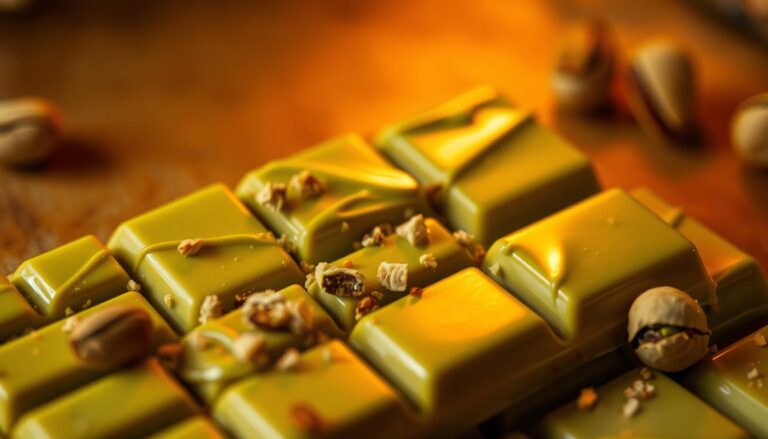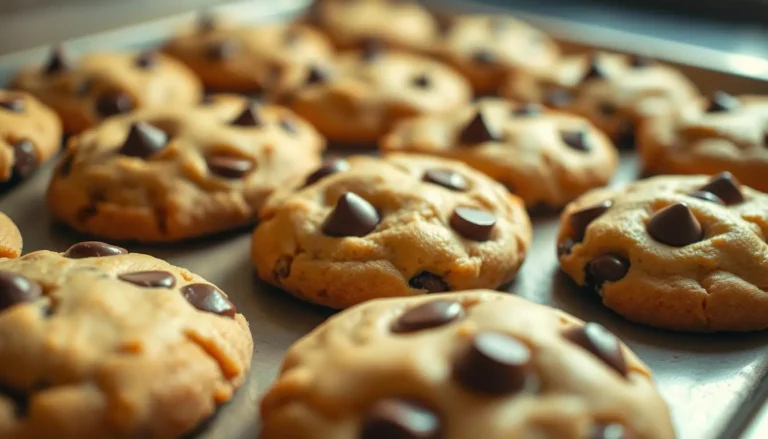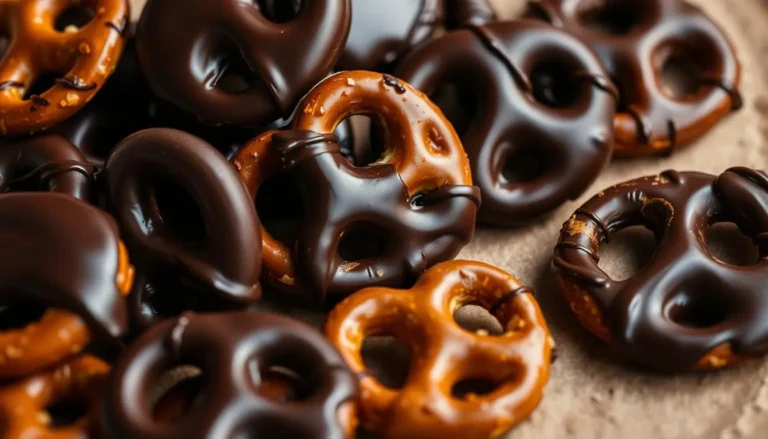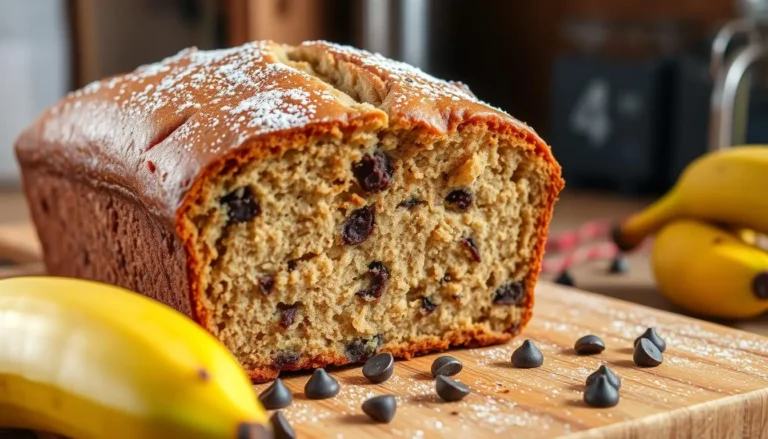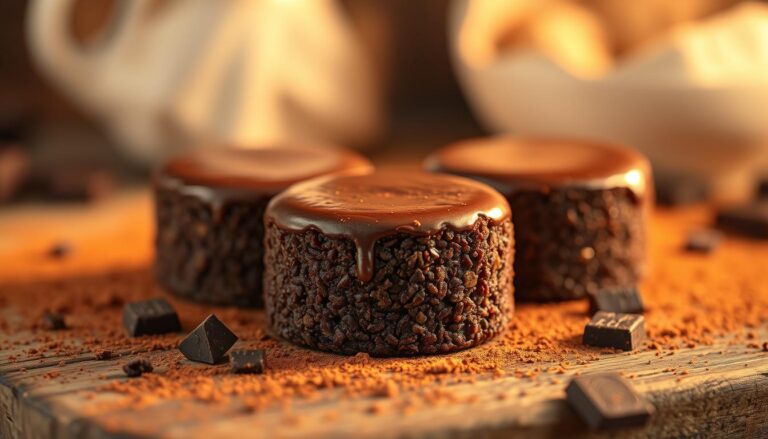The Best Soft Chocolate Chip Cookies You’ll Ever Make
Every kitchen has a story. Mine starts with the warm, inviting aroma of soft chocolate chip cookies. These cookies turn ordinary moments into memories. My grandmother’s homemade cookie dough was more than a treat. It was a ritual of love and connection.
Imagine biting into a cookie that’s perfectly soft. Chocolate chips melt on your tongue, creating bliss. This isn’t just another recipe. It’s a carefully crafted method for the most incredible soft chocolate chip cookies.
Whether you’re new to baking or experienced, these cookies will be your new favorite dessert. We’ll guide you through every step. We’ll share secrets that make a simple cookie unforgettable.
Key Takeaways
- Learn the ultimate soft chocolate chip cookie technique
- Discover professional baking secrets
- Create cookies with perfect texture every time
- Understand the science behind great cookie making
- Transform your home baking skills
Why These Chocolate Chip Cookies Are Different

A close-up view of a freshly baked chocolate chip cookie, capturing its soft and inviting texture. The cookie’s surface is gently mottled with golden-brown hues, hinting at the perfect blend of crisp edges and a pillowy interior. Tiny pools of melted chocolate chips dot the surface, their rich darkness contrasting beautifully with the cookie’s warm tones. Lit from above with soft, diffused lighting, the cookie’s craggy contours and delicate crumb structure are highlighted, inviting the viewer to imagine the satisfying bite and chew. Captured with a macro lens, the image emphasizes the cookie’s irresistible allure, drawing the eye to its enticing imperfections and the promise of a decadent, homemade treat.
Making the perfect chocolate chip cookie is more than just mixing ingredients. It’s about knowing the science behind the texture. To get the ultimate soft cookie, you need to learn some key baking secrets.
The Science of Cookie Texture
Cookie texture comes from how ingredients work together. The mix of sugar, butter, and flour is key. It decides if your cookies will be crunchy or soft. Bakers who know this can tweak small things to get big changes.
- Butter temperature impacts cookie spread
- Sugar type influences moisture retention
- Flour protein content affects cookie density
What Makes These Cookies Exceptional
These cookies are special because of unique techniques that make them soft. By controlling ingredient temperatures and mixing methods, you get cookies that stay soft and chewy for days.
| Technique | Impact on Cookie Texture |
| Chilled Dough | Prevents excessive spreading |
| Brown Butter | Enhances depth of flavor |
| Cornstarch Addition | Increases softness |
Learning these baking secrets will make your chocolate chip cookies irresistible. It’s all about knowing how each ingredient and technique affects the texture.
Essential Ingredients for Soft Chocolate Chip Cookies

A delicate arrangement of essential ingredients for soft, chewy chocolate chip cookies. In the foreground, a pile of semi-sweet chocolate chips, their dark hues gleaming under soft, even lighting. Behind them, mounds of all-purpose flour, granulated sugar, and brown sugar, their textures subtly distinct. In the middle ground, a pat of creamy butter and a farm-fresh egg, ready to be incorporated. In the background, a warm, wooden surface, the perfect backdrop for this baking scene. The overall mood is one of coziness and culinary anticipation, inviting the viewer to imagine the heavenly aroma and flavor of the cookies to come.
Starting with the right ingredients is key to making soft chocolate chip cookies. Each part plays a role in making a treat that’s both delicious and soft.
Quality ingredients are the base of a great cookie. Flour gives it structure, while butter adds flavor and softness. Sugars, both white and brown, add sweetness and moisture.
- All-purpose flour (essential for structure)
- Unsalted butter (for rich flavor)
- Granulated sugar
- Brown sugar (adds moisture)
- Large eggs
- Vanilla extract
- Baking soda
- Salt
Choosing the right chocolate is important. Chocolate chunks give a richer taste than regular chips. They make your cookies even more special.
Pro tip: Always use room temperature ingredients for the most consistent results!
Don’t overlook the importance of eggs. Large eggs help mix everything together and make the cookies soft and chewy. Using fresh, quality ingredients is crucial for success.
The Perfect Soft Chocolate Chip Cookie Recipe
Making the ultimate soft chocolate chip cookie recipe needs precision, passion, and expert baking tips. Every home baker wants to make those tender, melt-in-your-mouth cookies. They become instant family favorites.
To make an exceptional soft chocolate chip cookie, you must know key baking techniques. These techniques turn ordinary ingredients into amazing treats.
Measuring Tips for Success
Getting the measurements right is key to the perfect soft chocolate chip cookie recipe. Baking is a science that needs exactness.
- Use dry measuring cups for flour and sugar
- Level ingredients with a straight edge
- Invest in a digital kitchen scale for precision
- Avoid packed measurements unless specified
Room Temperature Ingredients Matter
Soft chocolate chip cookies start with ingredients at the right temperature. Warm butter and eggs create smoother, more consistent dough.
“Room temperature ingredients blend more evenly, creating a superior cookie texture.” – Professional Baker’s Secret
Mixing Methods Explained
Your mixing technique greatly affects the final cookie texture. Gentle folding prevents overworking the dough. This can make cookies tough.
- Cream butter and sugars until light and fluffy
- Add eggs one at a time
- Gradually incorporate dry ingredients
- Fold in chocolate chips gently
By following these baking tips, you’ll make soft chocolate chip cookies that impress everyone.
Secret Techniques for Ultra-Chewy Texture
Making the perfect chewy chocolate chip cookies is more than just a recipe. It’s about understanding cookie texture and using special techniques. These methods turn regular cookies into soft, chewy treats.
Professional bakers use certain strategies to get chewy cookies. The ingredients and how you prepare them are key to success.
- Chill your cookie dough for at least 24 hours to enhance chewy texture
- Use bread flour instead of all-purpose flour for increased protein content
- Incorporate more brown sugar than white sugar
- Slightly underbake cookies to maintain moisture
Choosing the right ingredients is crucial for chewy cookies. Brown sugar, with its molasses, keeps cookies moist and soft. This prevents them from becoming too crispy.
| Technique | Chewiness Impact |
| Using melted butter | Increases spread and chewiness |
| Adding corn syrup | Enhances moisture retention |
| Reducing egg whites | Creates denser, chewier cookies |
Pro tip: Experiment with different techniques to find your perfect chewy chocolate chip cookie texture. Each adjustment can subtly change the final result.
“The difference between a good cookie and a great cookie is in the details of texture and technique.” – Professional Baker
Choosing the Right Chocolate for Your Cookies
Choosing the right chocolate is key to making delicious cookies. The right chocolate can turn simple cookies into amazing treats. These treats will surely impress your family and friends.
Not all chocolate is the same for baking. Knowing the difference between chocolate chips and chunks can make your cookies stand out.
Chocolate Chips vs. Chocolate Chunks: A Detailed Comparison
| Feature | Chocolate Chips | Chocolate Chunks |
| Melting Properties | Designed to hold shape | Melt more readily |
| Texture Impact | Uniform distribution | Irregular, more dramatic chocolate pockets |
| Flavor Intensity | Mild and consistent | Rich and more pronounced |
Top Chocolate Brands for Baking
- Ghirardelli – Premium chocolate chunks with excellent melting properties
- Callebaut – Professional-grade chocolate with high cocoa content
- Valrhona – Gourmet option for serious bakers
When picking chocolate for your recipes, think about the cocoa percentage and where it comes from. Dark chocolate chunks usually have a deeper flavor than milk chocolate chips.
Pro tip: Chop high-quality chocolate bars into chunks for the most luxurious chocolate chip cookies!
Common Baking Mistakes to Avoid
Making perfect cookies needs precision and care. Many home bakers unknowingly mess up their chocolate chip cookie success. They make big mistakes during preparation.
Knowing common mistakes can change your baking game. Let’s look at the most common errors that stop you from making those irresistible treats.
- Overmixing the Dough: Too much mixing makes the cookies tough. Mix just until everything is combined for a soft texture.
- Incorrect Oven Temperature: A wrong oven temperature can ruin your cookies. Always check with an oven thermometer for the right temperature.
- Inaccurate Measuring: Baking is a science. Use precise measuring cups and level dry ingredients with a straight edge for consistent results.
New bakers often forget the importance of ingredient temperature. Cold butter and eggs can change the cookie’s texture and spread. Always let ingredients come to room temperature before mixing.
“Baking is about passion, precision, and patience.” – Professional Baker’s Wisdom
Your baking tips toolkit should include a few key strategies: use fresh ingredients, measure carefully, and pay attention to baking times. Small changes can make a big difference in making perfect cookies every time.
Professional bakers know that practice makes perfect. Don’t get discouraged by initial setbacks. Each batch of cookies is a chance to improve your technique and grow your baking skills.
Storage Tips to Maintain Softness
To keep your homemade cookie dough and soft chocolate chip cookies fresh, use smart storage. The right method helps keep that soft texture you love.
Understanding how moisture and air affect your cookies is key. Your soft chocolate chip cookie recipe needs careful storage to stay delicious.
Selecting the Perfect Storage Container
Look for containers that keep air out and moisture in. Here are some great options:
- Airtight plastic containers with tight-sealing lids
- Glass containers with rubber gasket seals
- Cookie tins with parchment paper between layers
Freezing Your Homemade Cookie Dough
Freezing is a great way to enjoy cookies whenever you want. Here’s how to do it right:
- Portion cookie dough into individual balls
- Place dough balls on a baking sheet
- Freeze for 1 hour until solid
- Transfer to freezer-safe storage bags
- Label with date and type of cookie
When you’re ready to bake, thaw the dough in the fridge overnight. Or bake it straight from frozen, adding 1-2 minutes to the usual time.
Thawing and Reheating Techniques
To make your cookies feel fresh again, try these reheating tips:
- Microwave for 5-10 seconds
- Warm in oven at 300°F for 3-5 minutes
- Use a slice of bread in the container to keep it moist
With these storage tips, your soft chocolate chip cookies will stay delicious for days.
Customizing Your Cookie Recipe
Turning your basic chewy chocolate chip cookies into something special is a fun journey. Your cookie dough is like a blank canvas, waiting for your creative touch. It’s a chance to make your treats truly stand out.
Looking to spice up your cookies? Here are some tasty mix-ins to try:
- Chocolate Variations:
- Dark chocolate chunks
- White chocolate chips
- Milk chocolate varieties
- Nutty Additions:
- Chopped pecans
- Sliced almonds
- Toasted walnuts
- Unique Flavor Boosters:
- Espresso powder
- Sea salt sprinkle
- Dried cranberries
Adding new ingredients doesn’t mean your cookies will lose their softness. Just remember to keep the right balance. Start with 1/2 cup of extra mix-ins to keep your cookies chewy.
Pro tip: Chill your dough for at least 30 minutes before baking. This step helps your cookies stay soft and chewy, just the way you like them.
High-Altitude Baking Adjustments
Baking cookies at high altitudes can be tricky. The thin air and lower atmospheric pressure change how ingredients react. This makes standard recipes less reliable.
To bake delicious chocolate chip cookies at high altitudes, you need to make some changes. These adjustments will help you make perfect treats every time.
Temperature and Baking Time Modifications
At elevations above 3,500 feet, you’ll need to adjust temperature and time:
- Increase oven temperature by 15-25 degrees Fahrenheit
- Reduce baking time by 2-4 minutes
- Watch cookies closely to prevent over-browning
Ingredient Ratio Adjustments
For high-altitude cookie ingredients, make these subtle but important changes:
- Decrease sugar by 1-2 tablespoons per cup
- Add 1-2 extra tablespoons of flour
- Reduce leavening agents like baking soda slightly
- Increase liquid ingredients by 1-2 teaspoons
Pro tip: Always test a small batch first to fine-tune your recipe for your specific elevation.
Troubleshooting Cookie Problems
Baking perfect cookies can be tricky. But knowing common challenges helps you become a master baker. If your chocolate chip cookies don’t turn out right, several factors might be at play. Let’s explore some baking secrets to help you achieve those irresistible treats every time.
Spread and Texture Issues
If your cookies spread too much or not enough, temperature is key. Warm butter creates flat cookies, while cold butter prevents proper spreading. Here are some quick fixes:
- Chill your dough for 30 minutes before baking
- Use room temperature butter
- Check your oven calibration
Preventing Burnt Bottoms
Burnt cookie bottoms can ruin your perfect cookies. Use these baking secrets to prevent overcooking:
- Use light-colored baking sheets
- Line sheets with parchment paper
- Position racks in the center of the oven
Measuring ingredients precisely and understanding your oven’s quirks can transform your baking experience. Experiment with these techniques, and you’ll soon create chocolate chip cookies that are soft, chewy, and absolutely delicious.
Making Cookie Dough Ahead of Time
Preparing your homemade cookie dough in advance can save you a lot of time. You can make the soft chocolate chip cookie recipe you love ahead of time. This way, you can bake when you’re ready, and it might even taste better.
When you make cookie dough ahead of time, you have two main options:
- Refrigerator storage (up to 3 days)
- Freezer storage (up to 3 months)
It’s important to store the dough properly to keep it fresh. Wrap it tightly in plastic wrap or use an airtight container. This helps keep moisture in and prevents odors from getting in.
| Storage Method | Maximum Storage Time | Recommended Baking Adjustment |
| Refrigerator | 3 days | Add 1-2 minutes to baking time |
| Freezer | 3 months | Add 2-3 minutes to baking time |
When you’re ready to bake, take the dough out of the fridge or freezer. Let it sit at room temperature for 15-30 minutes. This makes the dough softer and helps it bake evenly.
Pro tip: For freezer storage, roll the dough into individual cookie-sized balls before freezing. This allows you to bake exactly the number of cookies you want without thawing the entire batch.
Conclusion
Making the ultimate soft chocolate chip cookie recipe is an art. It combines precision, technique, and passion. Now, your baking skills are on a new level, thanks to these expert tips.
These secrets are more than just mixing ingredients. They show how temperature, ingredient quality, and mixing methods matter. Baking is about trying new things and enjoying the process of making something special.
As you try more dessert recipes, remember each batch of cookies has its own story. Your new knowledge lets you make each cookie a unique reflection of your baking skills. Whether for family, friends, or yourself, these cookies will bring happiness and satisfaction.
Embrace the magic of baking, trust your instincts, and keep learning. Your path to becoming a master baker begins with mastering the perfect chocolate chip cookie.
FAQ
How do I ensure my chocolate chip cookies stay soft?
To keep your cookies soft, use brown sugar. It keeps moisture in. Avoid overbaking and store them in an airtight container with a slice of bread. Chilling the dough and using room temperature butter also helps.
Can I use chocolate chunks instead of chocolate chips?
Yes, you can! Chocolate chunks make your cookies more intense and rustic. They melt differently, creating chocolate pools. Make sure they’re all roughly the same size for even baking.
How long can I store homemade cookie dough?
You can store cookie dough in the fridge for 3-4 days if wrapped well. For longer, freeze it for up to 3 months. Thaw it in the fridge overnight when you’re ready to bake.
Why do my cookies go flat when baking?
Flat cookies can come from several reasons. Warm butter, not chilling the dough, expired leavening agents, or a warm baking sheet can cause it. Make sure your ingredients are at the right temperature, chill the dough, and use fresh baking agents.
What’s the secret to getting a chewy chocolate chip cookie?
For chewy cookies, use more brown sugar than white sugar. Add an extra egg yolk and slightly underbake. Using melted butter also helps. These steps increase moisture and create a chewy texture.
Can I make these cookies gluten-free?
Yes! Use a gluten-free flour blend for baking. Make sure it includes xanthan gum for binding. You might need to adjust the liquid for the right consistency.
How do I prevent my cookies from burning on the bottom?
Use light-colored, aluminum baking sheets and line them with parchment paper or a silicone mat. Avoid dark pans. Place your oven rack in the center and rotate the baking sheet halfway for even baking.
Can I add nuts to this chocolate chip cookie recipe?
Definitely! Chopped nuts like walnuts or pecans add great texture and flavor. Add 1/2 to 3/4 cup of chopped nuts to the dough. Toasting them lightly before adding enhances their flavor.
Did You Try Our Recipe ?
There are no reviews yet. Be the first one to write one.


